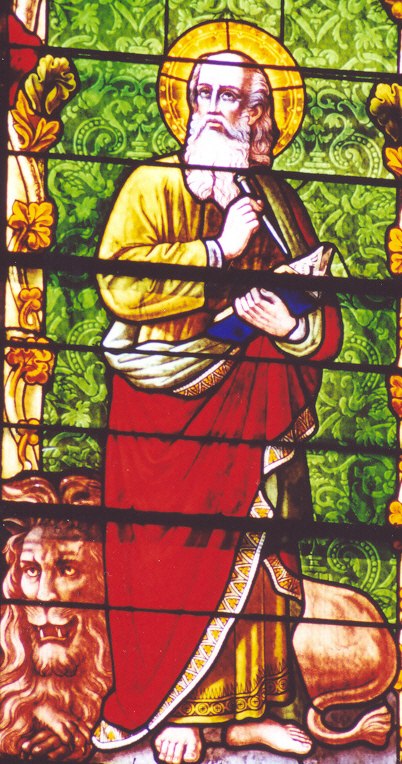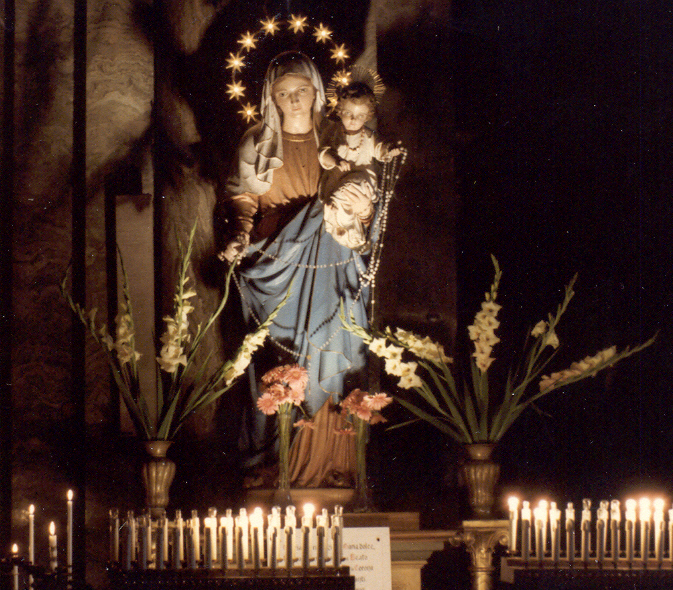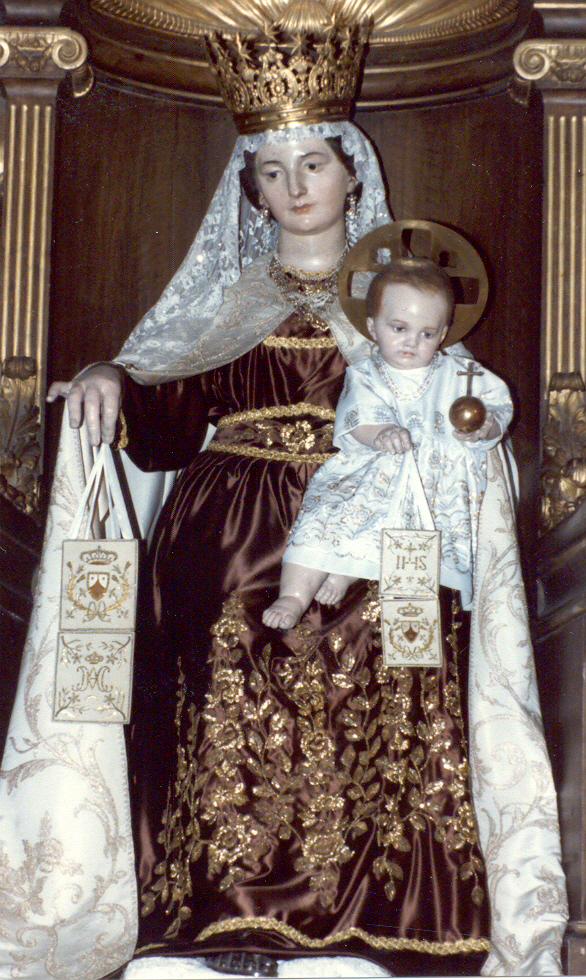
15th Sunday Ordinary Time
A Homily - B
Cycle - 2002-2003
First Reading - Amos 7:12-15
Psalm - 85:9-10, 11-12, 13-14
Second Reading - Ephesians 1:3-14 or 1:3-10
Gospel - Mark 6:7-13
Mark wrote to explain Christ
to the new Gentile converts.

Jesus summoned the Twelve and began to send them out two by two and gave them authority over unclean spirits. He instructed them to take nothing for the journey but a walking stick - no food, no sack, no money in their belts. They were, however, to wear sandals but not a second tunic. He said to them, "Wherever you enter a house, stay there until you leave. Whatever place does not welcome you or listen to you, leave there and shake the dust off your feet in testimony against them." So they went off and preached repentance. The Twelve drove out many demons, and they anointed with oil many who were sick and cured them.
During Ordinary Time, we priests are given a little bit of leeway to preach on topics that are particular at a specific time, so long as the homilies tie in the Gospel and have a catechetical nature to them. Some months ago, some of you may remember that I preached on the Just War Theory, just weeks before our conflict in Iraq began in earnest.
Today, I would like to focus our attention on two sacramentals: the Rosary and the Scapular. These are two of the most time-honored devotional tools of the Church and they deserve our consideration because their message is absolutely crucial for us as Catholics and is directly tied to today's Gospel.

Last October, His Holiness, John Paul II released a document by the name, Rosarium Virginis Mariae, Latin for the rosary of the Virgin Mary. By this document, the Pope wanted to rekindle a return to a more fervent practice of praying the rosary as individuals and as families. He went on to do two things: First, he declared the 12 month span from October 2002 to October 2003 to be the Year of the Rosary. Perhaps he chose October because that is the month in 1917 when the Blessed Mother had her most dramatic apparitions to the three shepherd children in Fatima, Portugal and exhorted us to pray the Rosary for the conversion of sinners and the Conversion of Russia, the latter of which seems to be in the making. Second, the Holy Father established five more mysteries of the rosary for us to pray - the five Luminous Mysteries or the Mysteries of Light, which allow us to meditate on the years of our Lord's public ministry.
So, as a review, there are four sets of mysteries:
1. The Joyful Mysteries: the Annunciation; the Visitation; the Nativity of our Lord; the Presentation of Jesus in the Temple; the Finding of the Child Jesus in the Temple (Recited on Monday & Saturday).
2. The Luminous Mysteries: the Baptism of our Lord; the Wedding at Cana; the Proclamation of the Kingdom with a call to conversion; the Transfiguration; the Institution of the Holy Eucharist (Recited on Thursday).
3. The Sorrowful Mysteries: the Agony in the Garden; the Scourging at the Pillar; the Crowning with Thorns; the Carrying of the Cross; the Crucifixion and Death of our Lord (Recited on Tuesday & Friday).
4. The Glorious Mysteries: the Resurrection; the Ascension; the Descent of the Holy Spirit; the Assumption of Mary; the Coronation of Mary as Queen of Heaven and Earth (Recited on Sunday & Wednesday).
The Holy Father calls the Rosary the epitome of the Gospels for they give us insights into our Lord and our Lady's life in a meditative way. If you don't remember how to pray the Rosary, look it up on the internet. There are literally dozens of sites devoted to this devotion. I have to say that from personal experience, praying a family rosary was one of the most formative parts of my childhood. Each night after dinner, my family would gather around a statue of Mary that we had near my parents' bedroom and would sit or kneel to pray the rosary as a family - every night at 8 pm - no exceptions. At the same hour, my cousins and aunts and uncles would be in their homes across town on the other side of Manila praying the rosary as well and each year as the New Year was ushered in, we would gather at my grandmother's home to begin the year as a family - 15 cousins and 9 aunts and uncles - praying the rosary, entrusting our year to her maternal care on the Solemnity of Mary, the Mother of God. I would encourage you to take up similar traditions in your own families, if you haven't already. The nightly praying of the rosary contains a spiritual treasure for families beyond imagining. Granted, it wasn't hard for my family to pray each night living in Manila in the early to mid-1980s with so much political turmoil around us, but if we are truly serious about sanctity and the conversion of our enemies and the preservation of our nation, we will pray the rosary daily.
As many of you know, pious tradition credits the beginning of the rosary to St. Dominic, who received the rosary from the Blessed Mother in the early 13th Century as a tool to help preach to French heretics known as Albigensians who denied the mystery of Christ's incarnation. The word rosary comes from the Latin, rosarium which means rose garden, actually a common term used to designate a collection of similar material, such as an anthology of stories.
The rosary gained popularity in the 1500s, when Pope Pius V asked all of the Catholic faithful to pray the rosary for the intention of beating back the Muslim Turks who were knocking at the doors of Vienna. The Muslims were beaten back on October 7, 1571 at the Battle of Lepanto, and our Lady was invoked on that day under the title of Our Lady of Victory. A year later, October 7 was established as the Feast of the Holy Rosary. This is also another reason why the Holy Father chose October to be the beginning of this year of the Rosary. The Holy Father tells us that the Rosary is man's prayer for man; a prayer of human solidarity, the collegial prayer of the redeemed that reflects the spirit and the intent of Mary, the first of the redeemed. With all the recent talk about weapons of mass destruction, perhaps we should dedicate ourselves to using the rosary as a weapon of mass construction. We are in desperate need of our Lady's intercession in these very uncertain times. Pray the rosary in the car - it prevents road rage; pray the rosary on the Metro or when you walk around the neighborhood - you won't believe what a great conversation piece it is.
The second sacramental for our consideration is the scapular. Unfortunately, its use has fallen out of practice among most Catholics. I am often amazed at how few Catholics today even know about the scapular.

A friend of mine tells a story of how he was in Duck, North Carolina, in the Outer Banks with some friends on vacation. He and another friend were playing a game of catch, throwing a baseball back and forth on the beach. They had their shirts off but their scapulars on. Meanwhile a group of college guys were further down the beach, about 20 yards away, tossing a lacrosse ball around. When one of them overthrew his partner and their lacrosse ball landed at my friend's feet, one of the college guys ran up, and asked my friend to toss the ball back to him. As my friend returned the ball, the collegian said, "Hey dude, what's up with the tea bags?" - pointing at his scapular. My friend replied, "It's a scapular," to which the collegian replied, "Ok, dude, cool," oblivious to what it was.
This Wednesday is July 16 - the memorial of Our Lady of Mt. Carmel, which is directly tied to the scapular. The brown scapular was given to St. Simon Stock in the year 1250 by the Blessed Mother. She promised that everyone who wore it and lived piously would escape damnation, have her protection and be released quickly from purgatory. If you would like to be invested in the brown scapular, give me a call at the office and I'll make arrangements for you. The scapular is a miniature version of the habit that religious sisters and brothers wear. It is worn under the clothing. I cannot tell you how many times I have heard stories of how the scapular protected a young man and young women from impure acts because when the scapular was seen under the clothing it was a sign for that couple to stop sinning.
There's a certain poverty associated with wearing the scapular - it's not exactly the most attractive piece of clothing but it does promote modesty of dress because people generally like to hide it under their clothing, which presumes, of course, that they're wearing enough clothing with which to hide it in the first place. This type of poverty is the kind of stuff that our Lord speaks of in our Gospel today - a detachment from material things, including paying inordinate amounts of attention to how we look, as the beginning of real spiritual poverty - an emptying of oneself of one's desires and opening oneself up to God's plan. This is not to say that we shouldn't be well kept and well-groomed but it is to say that we are detached enough of our appearance so that it does not become a form of idolatry in our lives.
St. Dominic, to whom the foundation of the rosary is often attributed to, as I mentioned earlier, died in the year 1221 with a very simple message to his brother Dominicans - possess poverty - that is, to exercise self-denial in order to be possessed by Christ.
Through our praying the rosary in this Year of the Rosary and our wearing the scapular, may we learn to cultivate a true spirit of self-detachment and total dependence on God and may we draw ever closer to the Heart of Mary, who wishes to draw us ever closer to the Sacred Heart of Her Son.
Praised be Jesus Christ! Now and forever!
If you find this material
valuable, consider a tax deductible gift to support this site.
The DaCapo Foundation • 2402 Tricia Ct. • Vienna VA 22181